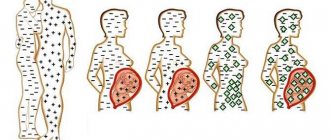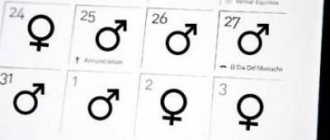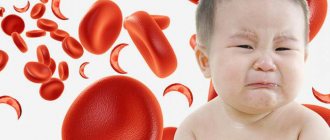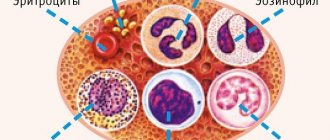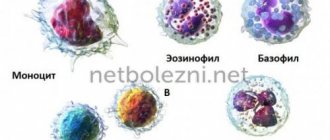A blood type test is a clinical test that determines the individual characteristics of a person's red blood cells. The blood group is usually called the totality of all antigenic properties of red blood cells. This analysis is necessary when transfusion or receiving donor blood. Not all types are compatible, so it's important to know your group. Ingestion of incompatible blood can result in a lethal immune response.
How many blood types are there?
It would seem that all blood looks the same, but no, it contains specific red blood cell antigens, called A and B, due to which the main body fluid has special differences and is divided into types. Let's look at what blood types are:
- the first (0) – does not contain specific antigens;
- the second (A) – has only antigen A;
- third (B) – has only antigen B;
- the fourth (AB) – “can boast” of containing two antigens A and B.
What is the Rh factor (Rh)? This term refers to the protein lipoprotein, which is located on the surface of red blood cells. Based on its presence or absence, blood groups are divided into positive (Rh+) and negative (Rh-). Medical statistics show that only 15% of people have negative Rhesus, all the rest live with the positive group.
So, how many blood types does a person have? In the case of directly identifying general types, there are four of them, but if we take into account the fact that each of them can have both a positive and a negative indicator, then human blood can be divided into 8 subgroups.
Disadvantages and advantages of the technique
The test will require blood sampling from both parents and offspring. Next, depending on the chosen method, the composition of the collected material is studied.
A child's blood counts will depend on the combination of his parents' genetic material. The resulting variations will not always be similar to the original sets of genes.
The determinant of the human blood group is the ABO gene, which has 3 forms: A, B, O. Due to the presence of a double set of chromosomes, the following combinations can occur: AA, BB, AO, AB, BO, OO.
The most important advantage of the method of identifying kinship using blood parameters is its low cost (compared to DNA testing). The price can range from 15 to 75 thousand rubles, which allows the examination to be carried out by a wide range of people.
The method of identifying kinship based on blood parameters has a number of negative characteristics:
- the analysis cannot be carried out before the baby is born;
- the same blood counts between the father and the minor are not proof of consanguinity, they only indicate its probability;
- insufficient reliability;
- There are cases when an offspring has a blood type that does not match the parent’s. But this fact does not indicate the absence of a blood connection.
Some statistics in percentages about people by blood type
As we have already found out, human plasma has 8 subgroups. An interesting fact is that the percentage of people by blood type differs significantly and has the following form:
| Human blood subgroup | Percentage of people by blood type |
| First positive (0+) | 36,4% |
| First negative (0-) | 4,3% |
| Second positive (A+) | 28,3% |
| Second negative (A-) | 3,5% |
| Third positive (B+) | 20,6% |
| Third negative (B-) | 1,4% |
| Fourth positive (AB+) | 5,1% |
| Fourth negative (AB-) | 0,4% |
Analyzing the statistics, we can say that a positive Rh factor is predominant and is present in 85% of the population. As for blood plasma, the first group is dominant in both the positive and negative subgroups. It is type I that is the main one for transfusion, because it can be used for all other groups, although such blood itself does not accept any other subgroup.
The same table answers the question of which blood group is the rarest in the world. This is the fourth negative, which flows in the veins of only 0.4% of the world's population.
Let's sum it up
The method of identifying kinship based on blood indicators has one exceptional feature - with its help it is possible with almost 100% probability to refute the blood relationship between the baby and the alleged father.
That is, it is impossible to identify a close blood relationship with high probability between a man and a baby based on blood type. Additional DNA testing will be required. But it is possible to exclude a blood connection, because if a baby is diagnosed with a blood type that differs from those given above for certain groups, then it can be argued that the citizens who donated blood for examination are not relatives.
If you want to find out how to solve your particular problem, please use the online consultant form below or call: free call
8
(for residents of Moscow and the region)
8
(for residents of St. Petersburg and the region)
Determining paternity by group, as a rule, does not give accurate and sufficiently reliable results. The most effective way to establish kinship is DNA analysis. It allows you to determine the similarity of the DNA of the child and the alleged father. The obtained result of such a test has legal force.
Parental compatibility, or what is meant by Rh conflict
It turns out that in order to conceive a child, potential parents must be compatible in blood type and Rh factor. Quite often, medical practice uses such a concept as parental incompatibility. What it is?
Incompatible parents
Many couples face such a problem as the lack of children. The examination reveals the incompatibility of a man and a woman, due to which the long-awaited first-born “does not work out.” To conceive a child, ideally the same Rh should be present, since otherwise, the course of labor may end in the following tragedies:
- If the woman is (-) and the man is (+), then the development of Rh conflict and fetal rejection with subsequent miscarriage is possible.
- When the woman is (+) and the man is (-), pregnancy is difficult, but if a miracle occurs, pregnancy continues without interruption.
Rhesus conflict, how not to lose a child
Typically, women with Rh- suffer from Rh conflict, since when conceived from an Rh+ owner, in 80% of cases the child receives the paternal Rh positive. And the immune system of a “minus” pregnant woman regards an embryo with a plus factor as pathogenic foreign cells and puts up active resistance, in every possible way excluding its presence in the female body. The fetus's red blood cells are attacked by the antibodies produced by the pregnant woman, leading to the loss of red blood cells.
The embryo, fighting for life, produces new ones, which leads to an enlargement of the spleen and liver. Such rapid growth causes oxygen deprivation, leading to brain damage and, as a consequence, the death of the unborn child.
An expectant mother who is Rh negative should be under constant supervision of a gynecologist. She needs to be constantly tested for the presence and amount of antibodies produced.
The newborn's blood is immediately taken to determine the Rh factor. If he is Rh positive, then the “minus” woman is given anti-Rh immunoglobulin as quickly as possible. This is done in order to be able to bear and give birth to another healthy toddler in the future. Anti-Rhesus immunoglobulin is also administered if a pregnancy with Rh-conflict ends in miscarriage or artificial birth in the later stages.
Disadvantages and advantages of the technique
This method of studying blood parameters involves focusing on the presence (absence) of antibodies in the blood structure. Each group contains certain antibodies. Below is a table with probable forms according to the ABO classification.
| Mother, blood type | Father, blood type | |||
| I(O) | II(A) | III(B) | IV(AB) | |
| Probability of offspring's blood type | ||||
| I(O) | I(O) | II(B), I(O) | III(B), I(O) | II(A), III(B) |
| II(A) | II(A), I(O) | II(A), I(O) | II(A), III(B), IV(AB) | |
| III(B) | III(B), I(O) | III(B), I(O) | II(A), III(B), IV(AB) | |
| IV(AB) | II(A), III(B) | II(A), III(B), IV(AB) | II(A), III(B), IV(AB) | II(A), III(B), IV(AB) |
Blood type of the child from the parents, table with Rh factor
Blood type is a genetically inherited factor that is inherited from mom and dad. What blood type the child will have can be calculated. How? Now we'll explain everything. Table of the possible blood type of a newborn based on the parents’ indicators:
The table clearly shows how specific erythrocyte antigens A and B are distributed. It should be noted that a parent with the first group cannot have a child with indicators of both A and B, even if the second parent has two of these antibodies. But those with IV(AB) will never get a child with group I(0). The most unpredictable are the results for parents who have all three types of indicators (A, B, 0) between them, for example, the mother has (A0), and the father (AB), here the child can inherit any of the four groups.
As for the Rh factor, it is inherited in a recessive-dominant manner. Rhesus positive is considered dominant, and rhesus minus is considered to be recessive, so if one of the parents has Rh+, then in up to 90% of cases the toddler will be born “positive”. Let's imagine the blood types of a child from his parents, in the form of a table with Rh factors.
| Mother's Rh factor | Dad's Rh factor | Possible Rh factor of the child in % |
| Rh+ | Rh+ | (Rh+) – 75%, (Rh-) – 25% |
| Rh+ | Rh- | (Rh+) – 50%, (Rh-) – 50% |
| Rh- | Rh+ | (Rh+) – 50%, (Rh-) – 50% |
| Rh- | Rh- | (Rh-) – 100% |
The times when mother III(B0) and father II(A0) born child IV(AB) were considered “fed up” have sunk into oblivion, today science has proven that human blood is inherited from parents, and its subgroup can be unpredictable and differ from parental. People preparing to become parents are simply obliged to know their Rhesus, since the compatibility of these indicators directly affects whether you will become happy parents or not.
Share the article on social media. networks:
Where to go
It is impossible to even predict, much less accurately calculate, what eye or hair color a child will be born to a particular couple. But, on the other hand, it is quite easy to predict and scientifically substantiate what blood type the baby will have.
Just over a hundred years ago, scientists discovered and proved the existence of four blood groups. The system of dividing blood into groups, which doctors still use today, is called “AB0”, where “A” and “B” are the designation of agglutinogens (erythrocyte antigens). The first blood group is characterized by the complete absence of antigens, the second by the presence of “A” antigens, the third by “B” antigens, and the fourth involves the presence of both types of agglutinogens simultaneously.
After this discovery in medicine, the level of risk of losses during the blood transfusion procedure, which were caused by the incompatibility of the patient’s and donor’s blood, was minimized. And since then, the blood transfusion procedure has become more popular in medical practice and with its help, countless lives have already been saved.
Further blood research by genetic scientists has opened up the opportunity for future parents to predetermine the blood type of their future, unborn baby with a high level of probability.
The discovery of the existence of four blood groups was proven by scientists at the beginning of the twentieth century. What blood type will the child inherit?
While mixing blood serum taken from some people with red blood cells taken from other people, Karl Landsteiner discovered that when the red blood cells and serums are combined separately, they begin to “stick together” - the red blood cells stick together and clots form.
While studying how red blood cells are built, Landsteiner discovered substances of a special nature in them.
He divided them into A and B categories, and created a third, which included cells that did not contain special substances. A little time later, A. Sturli and A. Von Decastello, Landsteiner’s students, identified red blood cells that simultaneously contained markers of the A and B categories. The result of research is the ABO system, according to which blood groups are divided. We still use it today.
I ( 0 ) – characteristically absent ant in A and B;
II (A) – the presence of antigen A is characteristic;
III ( B ) – set in the presence of ant-v B; IV ( A
B) – is installed in the presence of ant-B A and B.
This discovery helped eliminate losses during transfusions that occurred due to incompatibility of the patient’s blood with the donor’s blood. There are known cases of successful transfusion even before this discovery, for example, the case of a woman in labor. When she was infused with 250 ml of donor blood, she said, she felt life itself filling her body.
Don't hang this on your refrigerator.
But until the beginning of the twenty-first century, the implementation of this kind of manipulation was rare, and was performed exclusively in emergency cases, at times causing more harm than good. Austrian scientists made a great discovery, thanks to which they significantly made blood transfusion procedures safer, which saved many lives.
The ABO system has completely changed the way scientists think about the nature of blood. Subsequently, genetic scientists proved the identity of the principles of obtaining a child’s blood type and the principles of obtaining other characteristics. The second half of the nineteenth century was marked by the fact that Mendel formulated these laws, guided by the results of experiments on peas, known to us through biology textbooks.
Child's blood type. What blood type will a child inherit according to Mendel?
1. Mendel's laws state that parents with the first blood group will produce children without A- and B-types.
2. If the husband and wife have the first and second, then the children will have the same blood groups. The situation is similar with the first and third groups.
3. People with the fourth group can have children with either the second, or the third, or the fourth, but not the first. In this case, the partner’s antigens have no effect.
4. If the parents have the second and third groups, then the child’s group is absolutely impossible to predict. Their children can become owners of any group of four.
https://www.youtube.com/watch?v=EBT-GfJ-XHs
5. But where without exceptions. There are people who have A and B ant in their phenotype, but they do not manifest themselves. Such cases are very rare, and often among Hindus, which is why they are called the “Bombay phenomenon.”
When a child with a negative Rh factor is born in a family of parents with a positive Rh factor, great surprise arises, and even sometimes mistrust in the form of reproaches and doubts about the honesty of the spouse. But there is a simple explanation for this problem.
The Rh factor is an antigen (protein) located on the surface of erythrocytes, red blood cells. About 85% of people have this very Rh factor, that is, they are Rh positive. The remaining 15% who do not have it are Rh negative. These factors are denoted by the letters Rh, positive with a plus sign, negative with a minus sign. To study Rh, usually take one pair of genes.
DD or Dd is a positive Rh factor, and is a dominant trait, dd is negative, recessive. If a couple has heterozygous Rhesus (Dd), then in 75% of cases their children will also have positive Rhesus, and 25% negative.
If parents have Dd x Dd factors, then their children will have DD, Dd, dd. Heterozygosity appears in a child as a result of the conflict of the mother’s Rh-negative factor, so to speak, and can be transmitted to many generations.
What else can a child inherit?
For many centuries, parents have fantasized about what their child might be like. Today, thanks to ultrasound, you can look into the future and find out what gender the child will be, see the anatomical and physiological characteristics of the baby.
With the help of genetics, you can predict the color of a child’s eyes and hair, and the likelihood of having an ear for music. These traits are divided into dominant and recessive, and the probability of inheritance can be determined using Mendel’s laws. Dominant characteristics include brown eyes, curly hair, and the ability to curl the tongue into a tube. They have a very high probability of inheritance.
Unhappy, but also dominant signs are early baldness and graying, gaps between the front teeth, myopia.
Blue or gray eyes, straight hair, light-colored skin, and an average ear for music are recessive traits that are less likely to be inherited.
What gender will the baby be?
For many centuries, a woman was responsible for the absence of an heir in the family. To achieve their goal, women had to go on diets and count the days to conceive.
Let's look at this situation from a scientific point of view. Eggs and sperm have 23 chromosomes (half set), 22 of which match the partner's sex cells. But the last pair does not match, the female pair is XX, and the male pair is XY.
Therefore, the sex of the unborn child depends on the set of chromosomes of the sperm that fertilized the egg. That is, the dad bears full responsibility for the gender of the baby!
How is blood type inherited?
Table: How a child’s blood type is inherited (dependence of the child’s blood type on the blood type of the mother and father)
We invite you to familiarize yourself with the difference between the powers of appeal and cassation in criminal proceedings
Table 2. How the blood type of the Rh system is inherited (dependence of the rhesus of the child’s blood group on the rhesus of the father and mother)
This is explained by the fact that for a long time it is the mother who influences the formation of the child’s personality and therefore a non-Jewish woman will not be able to raise a true representative of the people who observes all traditions and customs. Therefore, marriage with a foreigner was not only condemned in society, but was also considered a crime before God.
But it is worth noting that if a woman accepted Judaism and complied with all its requirements, she and her children were recognized as Jews. Demographic Another answer to the question “Why is the nationality of Jews determined by their mother?” sounds like this: Jews, like other peoples, took part in wars and, as a result, many men remained on the battlefield.
A person's blood type is formed in the womb and remains unchanged throughout his life. With very rare and almost incredible exceptions. A child always inherits the blood type of his parents, this is a known fact. However, it also happens that for some reason she does not coincide with any of the baby’s biological relatives. And this is an absolutely normal and very common phenomenon that has its own laws.
To establish paternity, the applicant must apply to the district or city court. The claim is filed at the place of residence of the defendant, with the exception of certain cases when the claim is filed by the mother:
- if the child has a disability group;
- if he is incapacitated.
The following may file a claim to establish blood relationship:
- mother of the child;
- the child himself after reaching adulthood;
- an authorized representative with a notarized power of attorney;
- government agencies involved in guardianship and trusteeship;
- father of the child.
Another important feature of the examination is the consent of the minor if he is over 10 years old. If there is no consent, the procedure will not be carried out.
If the results of the examination confirm the paternity of the participant in the proceedings, the court will make an appropriate decision.
The parties will be given a 10-day period to appeal. After its expiration, participants can apply to the registry office with a court order to complete the necessary documentation. The certificate will be issued on the day of application. How to determine your baby's blood type: - table
| Mother father | ||||
| Child's blood type | ||||
| I gr. I gr. | I gr. (probability 100 percent) | — | — | — |
| I gr. II gr. | I gr. (50 percent probability) | II gr. (50 percent probability) | — | — |
| I gr. III gr. | I gr. (50 percent probability) | — | III gr. (50 percent probability) | — |
| I gr. IV gr. | — | II gr. (50 percent probability) | III gr. (50 percent probability) | — |
| II gr. II gr. | I gr. (25 percent probability) | II gr. (75 percent probability) | — | — |
| II gr. III gr. | I gr. (25 percent probability) | II gr. (25 percent probability) | III gr. (25 percent probability) | IV gr. (25 percent probability) |
| II gr. IV gr. | — | II gr. (50 percent probability) | III gr. (25 percent probability) | IV gr. (25 percent probability) |
| III gr. III gr. | I gr. (25 percent probability) | — | III gr. (75 percent probability) | — |
| III gr. IV gr. | — | I gr. (25 percent probability) | III gr. (50 percent probability) | IV gr. (25 percent probability) |
| IV gr. IV gr. | — | II gr. (25 percent probability) | III gr. (25 percent probability) | IV gr. (50 percent probability) |

